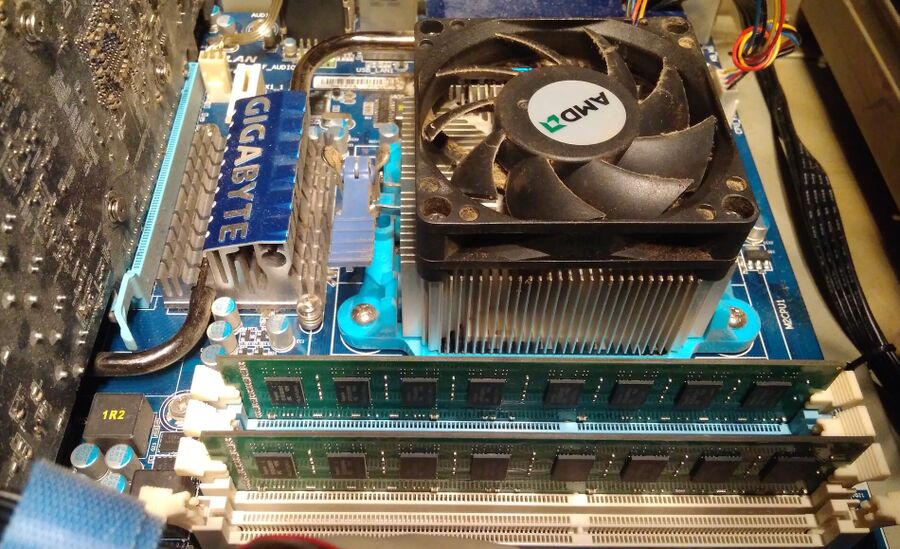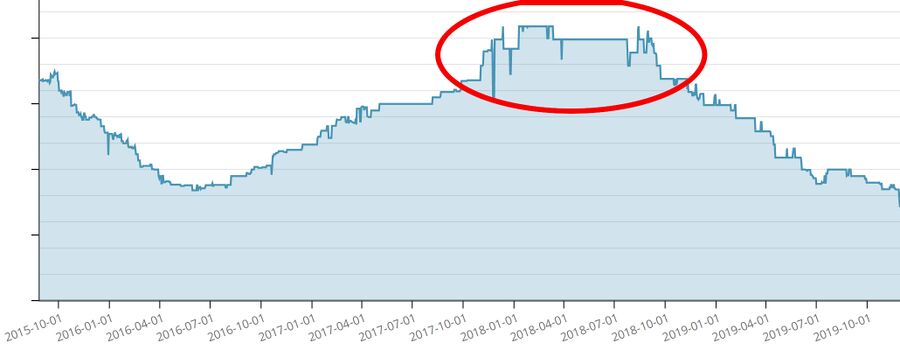Memory Chips Will See "Strong Demand" (=Rising Prices) In 2020
DDR4 RAM sticks are currently very affordable compared to the grossly overpriced state they were in for the entirety of 2018. RAM prices started going down at the start of 2019 and before dropping off a cliff in March. The price-slide continued from there making this a great time to pick up some DDR4 memory. Industry "experts" are predicting that the price-trend is about to change.
published 2019-12-05 - last edited 2019-12-05

DDR3 RAM sticks on a Gigabyte GA-MA790FXT-UD5P motherboard with a Athlon II x3 CPU. Gigabyte does not make beautiful motherboards with blue PCBs that are actually "Ultra Durable" anymore, now it's all about them shiny LED lights.
To put recent historical RAM-prices in perspective: 32 GB DDR3 memory would, in July 2015, cost you about the same as 16 GB DDR4 memory would cost you in July 2018. That's how overly expensive the three big RAM suppliers managed to make RAM: They Doubled the price for the same amount of RAM. Then China mumbled something about "investigating RAM price fixing" and the price-trend changed. A typical 32GB kit with 2x16GB of DDR4 memory rated at 3000MHz with a CL15 latency will currently cost you slightly less than 32 GB DDR3 would cost you back in 2015. Prices have normalized.

The price of a DDR4 RAM kit from Corsair 2015-2019. The price at it's height in 2018 (red circle) was around 2x the price mid-2016 as well as the price the second half of 2019.
RAM prices could be bottoming out[edit]
The industry research organization World Semiconductor Trade Statics Semiconductor Market Forecast published a report on December 3rd where they state that:
"“The memory market is expected to grow 4.1% to $110.3 billion in 2020 from $105.9 in 2019,”"
The South Korean investment firm Eugine Investment and Securities published a report on memory chip outlook on November 11th where they state that:
"Overburdened inventory is easing, and there is a sign that memory chip demand is recovering, particularly in the mobile phone and server sectors,"
Others in South Korea agree. Kim Yang-paeng from the Korea Institute for Industrial Economics & Trade gave this quote to the Asia Times this week:
"Lowered inventory levels mean that the downward pressure on memory chip price has eased, and expectations for a price hike are growing."
97% of all memory chips on the market are made by the three manufacturers Samsung (South Korean), Micron Technology (American) and SK Hynix (South Korean). SK Hynix is the biggest player followed by Samsung. American Micron Technologies is among the top 3 but they are light-wights compared to the South Koreans. There are also others making lower-quality slow DDR4 RAM but their combined marketshare is so low it's barely a rounding-error in SK Hynix's books. This is why predictions from "experts" and "industry analysts" out of South Korea tend to be spot on.
The Bank of Korea has decided that South Korea's GDP will grow by 2.3% in 2020. They cited "memory chip market recovery" as one of the reasons for making up that particular number.
"Recently, the downward trend of memory chip price has slowed, and leading indicators related to the semiconductor business, such as sales of equipment manufacturers for semiconductor manufacturing, are also improving.
We expect the semiconductor business to be in a recovery phase by the middle of next year. But, the recovery will fall short of what it was in 2018."
Late November, 2019
It sounds like the Bank of Korea has been informed by SK Hynix and Samsung that RAM prices will be gradually raised in 2020 - but only to levels below the 2018 highs.
More RAM is better than less RAM[edit]
The Linux kernel will automatically cache any and all files accessed as long as there's inactive memory to fill. Caches Are Faster than Direct IO which means that the more free RAM you have the faster and more responsive the system will be. 64 or 32 or just 16 GB RAM is preferable to having 4 GB RAM and this is specially true if you are using a GNU/Linux distribution.
This may be a great time to buy more DDR4 RAM if you have unpopulated RAM slots on your motherboard and you believe you may want or need more RAM in the future. RAM-prices are at a multi-year low and "experts" close to those who manipulate the supply in order to raise prices regardless of what demand looks like are telling you, very clearly, that prices are going to rise gradually throughout 2020.
Do get some RAM if you believe you will need it but don't just run out and grab some because it's cheaper now than it will be half a year from now. Buying things you do not need is stupid.


Enable comment auto-refresher